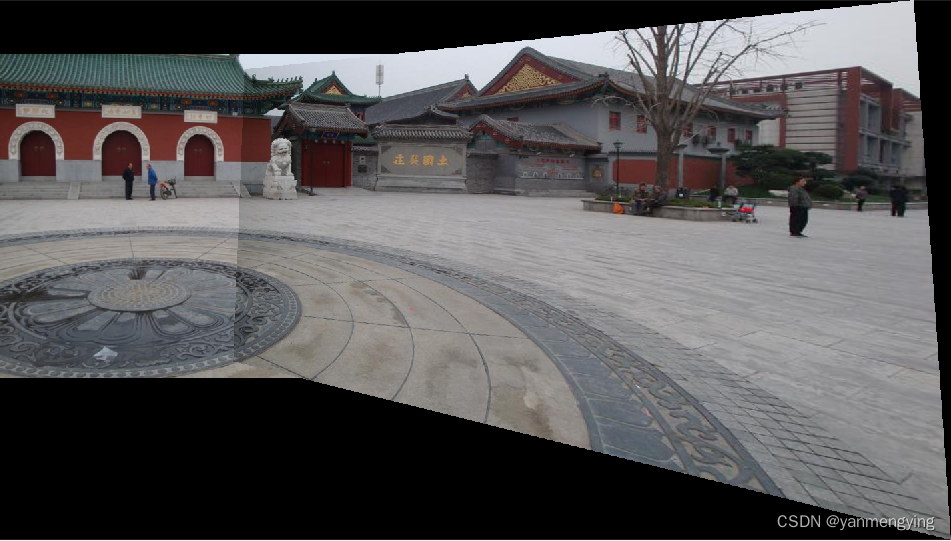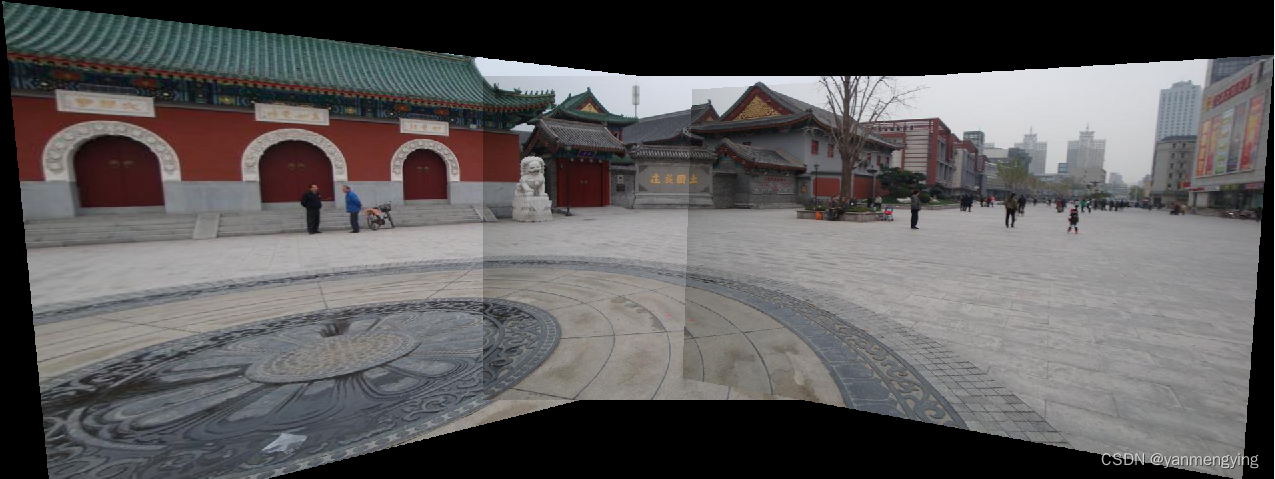matlab自带的拼接示例函数,可以拼接多张图像,效果一般,用的surf特征
% step1 Load images.
buildingDir =('F:\stitching\imagess\or\lt');%读取图片,把要拼接的图片放到这个文件夹中
buildingScene = imageDatastore(buildingDir);
% Display images to be stitched.
% montage(buildingScene.Files)%显示输入图片
%Step 2 - Register Image Pairs
I = readimage(buildingScene,1);
% Initialize features for I(1)
grayImage = rgb2gray(I);%grayImage = im2gray(I);
points = detectSURFFeatures(grayImage);
[features, points] = extractFeatures(grayImage,points);
numImages = numel(buildingScene.Files);
tforms(numImages) = projective2d(eye(3));
% Initialize variable to hold image sizes.
imageSize = zeros(numImages,2);
% Iterate over remaining image pairs
for n = 2:numImages
% Store points and features for I(n-1).
pointsPrevious = points;
featuresPrevious = features;
% Read I(n).
I = readimage(buildingScene, n);
% Convert image to grayscale.
grayImage = rgb2gray(I);
% Save image size.
imageSize(n,:) = size(grayImage);
% Detect and extract SURF features for I(n).
points = detectSURFFeatures(grayImage);
[features, points] = extractFeatures(grayImage, points);
% Find correspondences between I(n) and I(n-1).
indexPairs = matchFeatures(features, featuresPrevious, 'Unique', true);
matchedPoints = points(indexPairs(:,1), :);
matchedPointsPrev = pointsPrevious(indexPairs(:,2), :);
% Estimate the transformation between I(n) and I(n-1).
[tforms(n),~,~] = estimateGeometricTransform(matchedPoints, matchedPointsPrev,...
'projective', 'Confidence', 99.9, 'MaxNumTrials', 2000);
% Compute T(n) * T(n-1) * ... * T(1)
tforms(n).T = tforms(n).T * tforms(n-1).T;
end
%Step 3 - Initialize the Panorama对每个投影变化找到输出的空间坐标限制值。
for i = 1:numel(tforms)
[xlim(i,:), ylim(i,:)] = outputLimits(tforms(i), [1 imageSize(i,2)], [1 imageSize(i,1)]);
end
%计算每个变换X极限的平均值,找到中间的图像。只用X方向上的极限是由于场景为水平方向上的。
%如果有其他的图像,X和Y方向上的极限都应当用来查找中心图像。
avgXLim = mean(xlim, 2);
[~,idx] = sort(avgXLim);
centerIdx = floor((numel(tforms)+1)/2);
centerImageIdx = idx(centerIdx);
%将中心图像的反变换应用到所有的图像变换中。
Tinv = invert(tforms(centerImageIdx));
for i = 1:numel(tforms)
tforms(i).T = tforms(i).T * Tinv.T;
end
for i = 1:numel(tforms)
[xlim(i,:), ylim(i,:)] = outputLimits(tforms(i), [1 imageSize(i,2)], [1 imageSize(i,1)]);
end
maxImageSize = max(imageSize);
% Find the minimum and maximum output limits.
%创建一个空的全景图用来存放所有图像。
%用outputLimits方法计算所有变换中最小和最大输出限制。
%这个值用来计算全景图的大小
xMin = min([1; xlim(:)]);
xMax = max([maxImageSize(2); xlim(:)]);
yMin = min([1; ylim(:)]);
yMax = max([maxImageSize(1); ylim(:)]);
% Width and height of panorama.
width = round(xMax - xMin);
height = round(yMax - yMin);
% Initialize the "empty" panorama.生成空数据的全景图
panorama = zeros([height width 3], 'like', I);
%Step 4 - Create the Panorama
%用imwarp将图像映射到全景图中,再用vision.AlphaBlender将图像重叠起来。
blender = vision.AlphaBlender('Operation', 'Binary mask', ...
'MaskSource', 'Input port');
% Create a 2-D spatial reference object defining the size of the panorama.
xLimits = [xMin xMax];
yLimits = [yMin yMax];
panoramaView = imref2d([height width], xLimits, yLimits);
% Create the panorama.
for i = 1:numImages
I = readimage(buildingScene, i);
% Transform I into the panorama.
warpedImage = imwarp(I, tforms(i), 'OutputView', panoramaView);
% figure;imshow(warpedImage);
% Generate a binary mask.
mask = imwarp(true(size(I,1),size(I,2)), tforms(i), 'OutputView', panoramaView);
% Overlay the warpedImage onto the panorama.
panorama = step(blender, panorama, warpedImage, mask);
end
figure
imshow(panorama);结果图像:两张拼接、三张拼接


版权声明:本文为yanmengying原创文章,遵循 CC 4.0 BY-SA 版权协议,转载请附上原文出处链接和本声明。